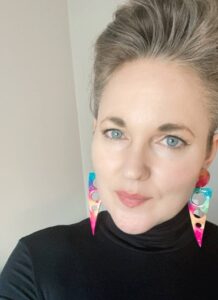ASLE’s Scholar of the Month for August 2021 is Emily Roehl.
 Emily Roehl is an energy humanities scholar and artist whose work has most recently appeared in Environmental History, Jump Cut, and Southern Cultures. Over the past two years, she has organized a series of events on energy justice, place-based research-creation, and lower-carbon research methods. Roehl is a Lecturer in the Honors College at Texas State University and the co-founder of artist book publisher Mystery Spot Books.
Emily Roehl is an energy humanities scholar and artist whose work has most recently appeared in Environmental History, Jump Cut, and Southern Cultures. Over the past two years, she has organized a series of events on energy justice, place-based research-creation, and lower-carbon research methods. Roehl is a Lecturer in the Honors College at Texas State University and the co-founder of artist book publisher Mystery Spot Books.
How did you become interested in studying ecocriticism and/or the environmental humanities?
I took a winding path to the environmental humanities, through theater and art and writing, but I can trace one of its branches to my first summer of college. I worked at the Grand Canyon, lived in a tiny cabin, and staffed the front desk at the El Tovar Hotel. I destroyed my feet hiking in ill-fitting shoes and failed to heed the warning signs not to hike down and back in one day. But I fell in love with the desert, and I’ve been plotting my return ever since.
Another branch leads into the past and into the future: to the site of my grave in Polk County, Nebraska, on the lands of the Pawnee Nation near Kíkatus, which settlers like my ancestors call the Platte River. The fact that I have a grave in a family cemetery in rural Nebraska fascinated and disturbed me as I began my graduate studies in English and ultimately led me to a PhD program in American Studies, where I learned the histories I wasn’t taught in school. I learned that Grand Canyon National Park occupies the lands of the the Hualapai, Havasupai, Navajo, Hopi, Paiute and Zuni Nations. I learned that the U.S. government paved the way for people like my Swedish ancestors to violently displace Indigenous peoples.
When I discovered that the Keystone XL pipeline was projected to run near my family’s cemetery and was being opposed by a coalition of Indigenous and settler organizers and artists, I knew I wanted to write about it. What I ended up writing was a dissertation on the contemporary art and media that has emerged from pipeline opposition. When I attended my first ASLE conference in 2015, I presented a paper called “Photographing the Underground” about extractive landscape photography in Alberta and the work of Maria Whiteman and Warren Cariou. That work has expanded to encompass three pipeline struggles: KXL, DAPL, and Line 3.
Who is your favorite environmental artist, writer, or filmmaker? Or what is your favorite environmental text? Why?
An artist I love and am currently writing about is Cannupa Hanska Luger, an enrolled member of the Three Affiliated Tribes of Fort Berthold. Luger was one of the many artists who gathered at Standing Rock in 2016 to oppose the Dakota Access Pipeline. While there, he initiated the Mirror Shield Project and began a series of collaborative pieces with the artist collective Winter Count. Luger is a multidisciplinary artist who uses ceramics, installation, performance, and community collaboration to create works that address Indigenous sovereignty and missing and murdered Indigenous women, girls, and two-spirit people. He has recently received many much-deserved awards, including the Smithsonian Artist Research Fellowship, a Creative Capital Award, and the Fellowship for Socially Engaged Art from A Blade of Grass.
What are you currently working on?
There are two projects that excite me the most right now: a digital artist residency with the Civic Laboratory for Environmental Action Research (CLEAR) in Newfoundland and Labrador, where I am collaborating on a workshop about map-making, oil, and anti-colonial methods, and a syllabus for a course on environmental justice art and media. I will teach the course in the Honors College at Texas State University, and I am looking forward to working with students from a wide variety of majors and methods, focusing on environmental justice issues in Central Texas.
What is something you are reading right now (environmental humanities-related or otherwise) that inspires you, either personally or professionally? Comment briefly on why or how it inspires you.
Both personally and professionally, I am inspired by the struggle against the Line 3 pipeline in what is now called Minnesota, which runs through occupied Anishinaabe lands and waters. Following the hashtag #NoLine3 on social media, I am reminded hour by hour of the tireless work of folks like Anishinaabe author and activist Winona LaDuke, who was recently jailed in Aitkin County for her continued resistance to the pipeline and who has spoken powerfully against the militarization of the police in response to pipeline resistance.
Is there a scholar in the field who inspires you? Why?
There are so many people in this field who inspire me. My mentor, Heather Houser, is a brilliant writer and a truly generous person. Rachel Jekanowski is someone I’ve been lucky to collaborate with on more than one occasion, and I’m always challenged and inspired by Rachel’s work. The same goes for Anne Pasek, whose low-carbon research methods and petro-zines delight me. I want to mention one more person who isn’t an environmental humanist but who nonetheless has powerfully shaped my thinking about the environment: my best friend Melissa. Mel is a soil scientist. When she does field work, she wears wading boots and safety orange; when I do field work, I wear whatever I like, because my field work is likely happening far from snakes and ticks and actual fields. People like Mel inspire me: people who wade through wetlands and grapple with bureaucracy and know how soil and environmental policy work.
